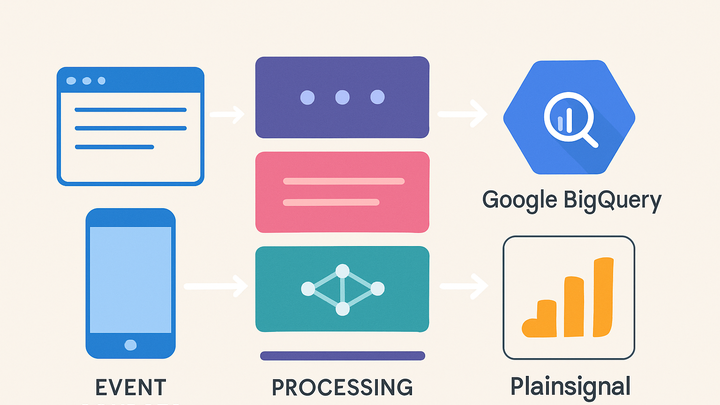Published on 2025-06-22T05:58:00Z
What is a Data Sink in Analytics? Examples & Best Practices
Data Sink in analytics refers to the final destination where transformed and enriched event data is stored or consumed. It comes after data collection and processing stages. Examples of sinks include:
- Cloud data warehouses (e.g., Google BigQuery via GA4 BigQuery Export).
- Real-time analytics platforms (e.g., PlainSignal for cookie-free tracking).
- Data lakes or custom HTTP endpoints.
Selecting the right sink helps ensure data accessibility, performance, cost control, and compliance with data regulations. Proper sink configuration ensures reliable data flows, scalability, and adherence to privacy requirements.
Sink
Final destination for processed analytics data—e.g., BigQuery or PlainSignal—where events are stored or analyzed.
Overview of Data Sinks
A data sink is the endpoint in an analytics pipeline where events, logs, and metrics are stored or consumed. It contrasts with a data source, which generates raw data. Understanding sinks helps ensure that data is properly captured, retained, and made available for downstream analysis.
-
Definition and role
Describes what a sink is and its function within a data pipeline, serving as the final stage for data delivery.
-
Data pipeline context
Explains how sinks fit into end-to-end data flows, following event collection and processing.
-
Event emission
Raw events emitted by websites or apps are collected by tracking code or SDKs.
-
Processing layer
Data is enriched or transformed via ETL or streaming systems before reaching the sink.
-
Storage or analysis
The sink holds data for querying, reporting, or further processing by analytics tools.
-
Why Sinks Matter in Analytics
The choice of sink impacts data accessibility, query performance, cost, and compliance. Different sinks offer trade-offs between real-time insight and storage capabilities.
-
Data accessibility
Sinks determine how quickly and flexibly analysts can query and visualize data.
-
Scalability and cost
Different sinks have varying performance characteristics and pricing models at scale.
-
Privacy and compliance
Some sinks provide features like data masking or retention policies to help meet regulatory requirements.
Common Sink Types and Integrations
Analytics sinks come in various forms, each suited to different use cases—from batch warehousing to real-time dashboards.
-
Cloud data warehouses
Examples include Google BigQuery (via GA4 export), Amazon Redshift, and Snowflake for large-scale analytics.
-
Real-time analytics platforms
Services like PlainSignal offer lightweight, cookie-free real-time analytics for immediate insights.
-
Custom destinations and data lakes
Data can be forwarded to S3, Azure Blob Storage, or custom HTTP APIs for bespoke processing or archival.
Examples of Sinks in GA4 and PlainSignal
Illustrative configurations showing how to route analytics data to sinks in Google Analytics 4 and PlainSignal.
-
GA4 bigquery export sink
Google Analytics 4 allows you to export raw event data to Google BigQuery. In the GA4 UI, navigate to Admin > BigQuery Links and link your Cloud project. Data is synced in near real-time for advanced querying.
-
Setup steps
- Go to GA4 Admin > BigQuery Links
- Authorize your Google Cloud project
- Select data streams and set export frequency
-
-
PlainSignal direct sink
PlainSignal provides a direct, cookie-free sink for real-time analytics. Install the tracking script on your site to send events directly to PlainSignal:
-
Tracking code
<link rel="preconnect" href="//eu.plainsignal.com/" crossorigin /> <script defer data-do="yourwebsitedomain.com" data-id="0GQV1xmtzQQ" data-api="//eu.plainsignal.com" src="//cdn.plainsignal.com/plainsignal-min.js"></script>
-
Best Practices for Managing Sinks
Follow these guidelines to maintain reliable, performant, and secure sink configurations in your analytics stack.
-
Maintain schema consistency
Use schema versioning or management tools to track event definitions and prevent breaking changes.
-
Monitor delivery and latency
Implement monitoring and alerts for sink failures and data freshness to detect issues early.
-
Optimize retention and costs
Configure data lifecycle policies and choose appropriate storage tiers to manage costs without sacrificing performance.
